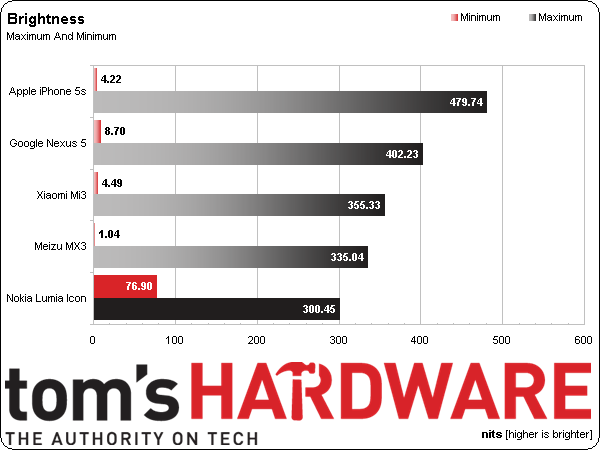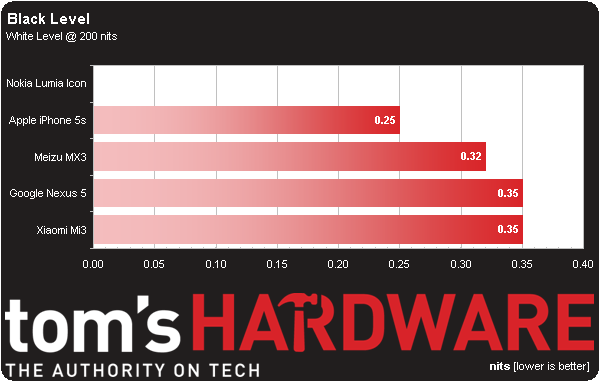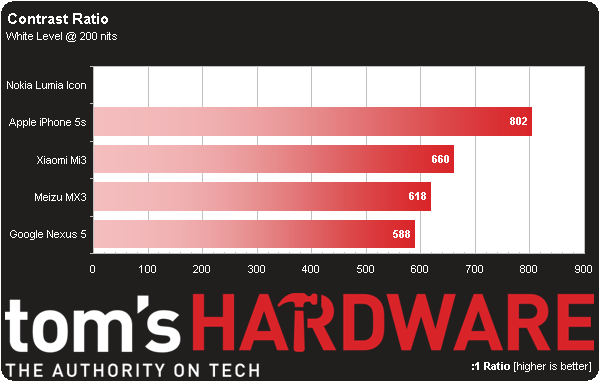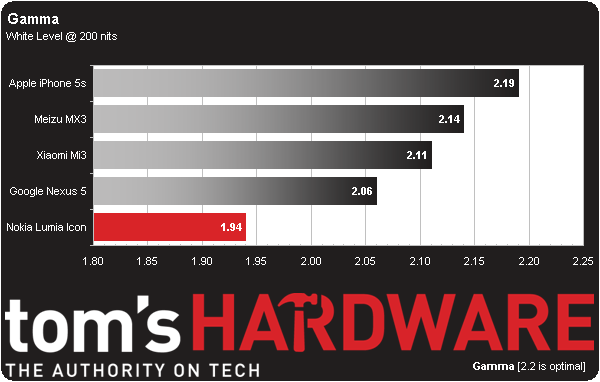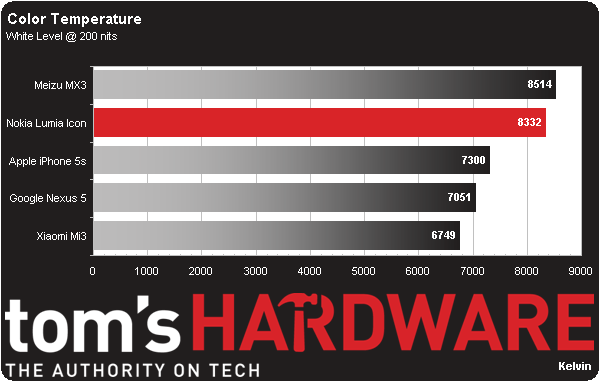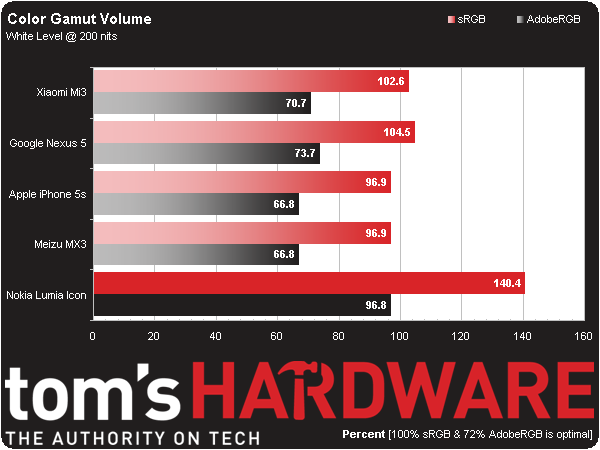Nokia Lumia Icon & Lumia 930 Review: Windows Phone, Premium
We took Nokia's Lumia Icon for a month-long test to really experience life with the company's flagship Windows Phone 8-based platform. Some of the benchmark results from this Snapdragon 800-powered powerhouse may surprise you.
Results: Brightness, Black Level, Contrast Ratio, And Gamma
Brightness
Brightness measurements are taken by recording the luminance output of each device displaying a full white pattern, with the brightness level set to both minimum and maximum values.
Nokia's Icon achieves the lowest maximum brightness result, though a peak of 300 nits was never an issue. The display is usable in all environments, even under direct sunlight.
In comparison, the Icon's minimum brightness score is actually pretty high. That's an artifact of Windows Phone 8's lack of a brightness slider. Instead, this is as low as we can get using the low setting.
Naturally, device comparisons are challenging with only three brightness options on the Icon. We typically dial devices into exactly 200 nits. But because the Nokia phone can't hit the number we need, we're testing at all three settings and extrapolating the results on a graph.
Black Level
Our black level measurement is the luminance output of a full black pattern after the full white has been standardized to 200 nits. It’s important to note that AMOLED displays always measure a black level of zero, since their pixels simply turn off to render black.
Boasting the only AMOLED display in our test group, the Icon is capable of a true zero black level. The iPhone distinguishes itself from the rest of the pack with a low 0.25 nit result. And the rest of the competition hovers around 0.35 nits.
Contrast Ratio
Contrast ratio is the difference between a full white pattern and a full black pattern. Due to their zero reading on black level tests, AMOLED displays are said to have an infinite contrast ratio.
Get Tom's Hardware's best news and in-depth reviews, straight to your inbox.
The AMOLED screen wins again, as the Icon and its infinite contrast level trumps the IPS-equipped competition. Once again, the iPhone 5s' display leads the rest of the pack with an 800:1 measurement.
Gamma
Gamma compensates for the linear brightness levels displayed by a monitor, versus the nonlinear way our eyes perceive light. A gamma curve of 2.2 is what we want to see. Let's see how these devices compare:
The iPhone rules this test. While the Lumia Icon's AMOLED display is technically capable of a wider color gamut than IPS displays, these are often improperly calibrated by the operating system, resulting in disappointing results. More surprising is how poorly the Nexus 5 compares to the other IPS-equipped devices.
Color Temperature
Color temperature is a measurement in Kelvin that is used to describe how “warm” or “cool” a given display is. Ideally, as long as you're not viewing your device in direct sunlight, this should be in the 6500 range. Higher color temperatures result in a cool, bluish hue, while lower temperatures deliver a warm or reddish tone.
The Lumia Icon delivers a very cool 8300-degree color temperature. Although this result is probably higher than it should be, that's also Nokia's default setting. You do get color temperature and saturation controls, unlike most of the Icon's competition.
Color Gamut Volume
Our volume measurements are compared against both the sRGB and AdobeRGB color gamuts. A reading of 100% on sRGB and 72% on AdobeRGB is optimal for viewing the vast majority of digital content. Lower results are typically accompanied by an overly red or yellow image. Meanwhile, a higher reading is usually too blue/green.
The Icon suffers from its AMOLED display. Despite having a larger gamut of colors to choose from, we can see it's not calibrated properly. The rest of the pack displays a much more desirable result closer to the 100/72 standard.
Current page: Results: Brightness, Black Level, Contrast Ratio, And Gamma
Prev Page Results: Web And Battery Tests Next Page Will The Icon Convert You From Android Or iOS?Don Woligroski was a former senior hardware editor for Tom's Hardware. He has covered a wide range of PC hardware topics, including CPUs, GPUs, system building, and emerging technologies.
-
Amdlova only problem on this phone is (verizon)... if you wanna spend 150us and a 1000 years contract. =) is right that numbers on benchies ? direct 3d working?Reply -
silverblue Sorry for the possible double post, but this comments section is bugged to hell, so...Reply
I'm surprised by the bloat. My 1020 (with Windows Phone 8.1) has 32GB, of which 29 is available, after O2's (slight) footprint. -
vaughn2k I have a Lumia 925. I will wait for the Windows Phone 8.1 update, that it seems promising... So the question if I will switch from IOS/Android to WP, then I guess I did, the 925 seems also a great phone, and the 'Store' has already a quite considerable amount of programs (or Apps)....Reply -
aldaia Wait, a "flagship Windows phone" powered by Qualcomm Snapdragon 800. Intel push into the smartphone market is certainly doomed.Reply -
tomfreak We just need Lumia 1020 sucessor = Lumia 1030 with snapdragon 800 to handle the 40MP picture. A 40MP Lumia 1030 with snapdragon 800 CPU + 2GB RAM + 32GB storage + SD card expansion + a 3000mah battery will be the killer phone that no one is able beat it. Photography takes a lot of battery drain, since thats how Lumia 1020 good at, I just hope Nokia/Microsoft put a much bigger battery inside for successor.Reply -
megamanxtreme All is well, I still got my Lumia 1520, and it still reigns the king. 920/930 with bigger screen, for the win.Reply -
Aoyagi Yeah, nice toys. About what the reviewer wanted, by the looks of it. But using these things as tools rather than toys for consuming media and maybe reading mail? No way.Reply
(I had been using Lumia 920 before I returned to 808 PureView. I still have it for testing purposes)
13186987 said:I'm surprised by the bloat. My 1020 (with Windows Phone 8.1) has 32GB, of which 29 is available, after O2's (slight) footprint.
Most of that is the OS itself. -
satish12321 Dude, how could you forget LIVE TILES. This single handedly put Lumia ahead of its competitors. Especially the new updates that will make it more informative.Reply
Android and iOs are like a graveyard of dead icons. If they font adapt, their fingerprint sensor, eye recognition and waterproofing wont be able to protect it. -
Au_equus Don, the specs listed in the table (first page) do not match the description given in the article.Reply -
jasonelmore why the hell does Verizon think they must put their logo on the phone? my god i would never buy a phone that had carrier branding on the front or back of the phone. Plus Verizon's logo is FuglyReply
